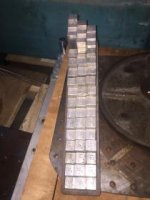There are two boxed sets, each block 1” x 3” x variable height, aluminum, two transverse holes per block. Each block has three heights in steps for various angles. These are shop-made. Edit: note that each step is marked on top with a whole number of degrees. My use of “height” may have been confusing. All angles 1-45 degrees are represented by at least one step. Each block has three steps, each 2 degrees apart.
Attachments
-
 F8508331-A0B8-42ED-8F37-B68D6A85CCF0.jpg9.9 KB · Views: 472
F8508331-A0B8-42ED-8F37-B68D6A85CCF0.jpg9.9 KB · Views: 472 -
 C18625B9-738D-467E-AC93-86DD06B0D65D.jpg9.4 KB · Views: 437
C18625B9-738D-467E-AC93-86DD06B0D65D.jpg9.4 KB · Views: 437 -
 D98416BA-FCE2-4C7F-9CCD-5957881C61C5.jpg7.2 KB · Views: 398
D98416BA-FCE2-4C7F-9CCD-5957881C61C5.jpg7.2 KB · Views: 398 -
 99D97F27-C46F-4CBB-8C5F-6ADD9CE3F31C.jpg9.7 KB · Views: 374
99D97F27-C46F-4CBB-8C5F-6ADD9CE3F31C.jpg9.7 KB · Views: 374 -
 9F3F0B9C-E35D-4CBC-A15D-92141B2EDEF5.jpg8.1 KB · Views: 316
9F3F0B9C-E35D-4CBC-A15D-92141B2EDEF5.jpg8.1 KB · Views: 316

